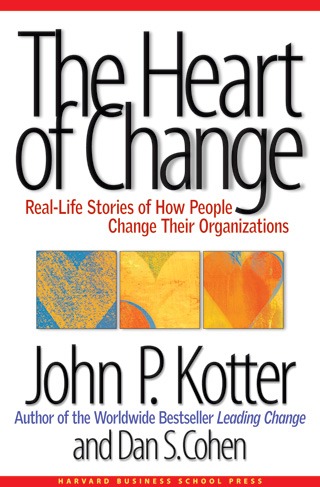The Heart of Change Summary
5 min read ⌚
 Real-Life Stories of How People Change Their Organizations
Real-Life Stories of How People Change Their Organizations
The logical inquiries are not the main cause that instigates people or organizational units to change.
The process focusing on “look, feel and change” has the crucial role.
Who Should Read “The Heart of Change”? And Why?
Educate your associates on how they will benefit from the transformation. Outline their importance in the company, don’t make them feel unworthy and stop with the bossy attitude.
Approach their heart, not their mind and confront these interrelated opposites. To save your company from financial collapse, promote or stimulate new perspective consisting of new methods. These tactics will prevent the business from going down by advocating dramatic changes.
“The Heart of Change” is interpreted as one of a kind – instruction manual; a manual suited for businessmen, entrepreneurs, managers, lawyers and every other person willing to explore the power of change.
About John P. Kotter & Dan S. Cohen
 John P. Kotter is a writer and a professor who spent a lot of his time teaching at the Harvard Business School. Since the 1970s he offered his expertise by writing numerous articles on “Change” and books covering the same topic including the award-winning bestseller “Leading Change”.
John P. Kotter is a writer and a professor who spent a lot of his time teaching at the Harvard Business School. Since the 1970s he offered his expertise by writing numerous articles on “Change” and books covering the same topic including the award-winning bestseller “Leading Change”.
 Dan S. Cohen momentarily heads the “Global Energy Change” company in which he applies the fundamental “transformation techniques”.
Dan S. Cohen momentarily heads the “Global Energy Change” company in which he applies the fundamental “transformation techniques”.
“The Heart of Change Summary”
In some business communities, the stability is all that matters. Companies are distracted by the influence of external factors – which is enormous. Consolidation of business positions is gaining momentum as well. Despite today’s economic turbulence and unpredictability, the business environment requires stability.
Some experts like the word – adaptability more, because firms are in “do or die” situation, flexible approach and openness to change is the only route to prosperity.
A lot of the people are still aversive to change, the author sidesteps individuals and emphasizes groups or organizations which share the same attitude. The problem emerges because most of the people don’t know or understand the starting point.
Their way of functioning is familiar to them, even if they successfully adapted to the new era in the past, they are not comfortable doing it all over again.
Time after time, managers in big companies try to encourage the organization to adopt a new error-free perspective. This point of view appeals to utilizing new technologies and methods in order to compete in the market.
Your employees or associates expect clear reports and guidance which will allow them to overcome the fear of transformation. However, frequently some of these tactics cannot “construct” the infrastructure of possibilities – if the sense of urgency is missing.
Become aware of the theory and endorse it – the “heart of change” is located at the very center of our being or in other words a mere reflection of our inner state (the emotions). Only a deep connection among you and your co-workers can spark that fire and motivate them to transform from risk-aversive to risk-takers.
Go one step at a time; organizational change requires individual change. Before you know it, the company itself may suffer the consequences if the executives don’t prove themselves as great leaders.
John P. Kotter and Dan S. Cohen, the authors of this concise life-altering book, began their journey by conducting a series of interviews – covering more than 400 individuals from 130 companies and ultimately saw the big picture.
Their central discovery is based on changing individuals before you take it to the next level or in this case – organizations of teams. Before you ask a change from your associates, make sure that you become the example of such.
Some readers may find the theory focusing on feelings “not productive, ” or even “boring,” but the authors inform against believing in reports and other external activity as tools for stimulating transformation.
Self-change, as the authors explained, doesn’t only refer to individual transformation, but also it covers organizational change which is quite harder to attain. Many firms are fighting with the aversiveness of their employees. Unfortunately, the results are devastating.
The techniques these companies use, tend to delude organization into thinking that all is going well and shortly after to take a turn into unexpected reality. The company’s turning point will not take place if that firm has a shortage of capable leaders.
These individuals need to assess the situation and resolve the unresolved problems, which are often hidden – behind the curtains. The ratio between change and the aversiveness of the same varies according to the knowledge that institution or individual possess.
Key Lessons from “The Heart of Change”
1. Adopt a perfect vision
2. Build a productive team
3. Almost nothing is impossible
Adopt the perfect vision
Once you manage to persuade the members of your organization that change is an imperative, the team will quickly shift from personally oriented to “we”.
This approach will give the leadership a new role from which the group will draw energy. The ultimate vision is far more significant than a strategy or a long-term plan because it concerns the entire company.
Build a productive team
After a new vision is set in place, the associates may start to feel the urge arising from it. If you’re keen for knowledge, try to convey that same approach to other members.
Build a competitive team, ready to take the struggle out from the company.
Almost nothing is impossible
The “it can’t be done” obstacles are just an excuse for incompetent leaders.
Even if some task or a job seems impossible to pull off, yet a stubborn manager who welcomes new ideas will try a several more times before the final “No”.
Like this summary? We’d Like to invite you to download our free 12 min app, for more amazing summaries and audiobooks.
“The Heart of Change” Quotes
Never underestimate the power of the mind to disempower. Share on X Never underestimate the power of clever people to help others see the possibilities, to help them generate a feeling of faith, and to change behavior. Share on X Everyone engaged in a big change effort...should probably have a banner above the mirror in his or her bathroom at home...that says, ’Dying will not help. Share on X Honesty always trumps propaganda. Share on X People change what they do less because they are given analysis that shifts their thinking than because they are shown a truth that influences their feelings. Share on XOur Critical Review
With a strong appreciation for the revelation, we believe that this book is a good fit for everyone; regardless of their level of education, nationality, race, age, gender.
Kotter and Cohen present his eight-step life-changing model which by all means demonstrate the practical side of transformation. Enriched by real-life stories of managers this book will surely get the best out of you.
Emir is the Head of Marketing at 12min. In his spare time, he loves to meditate and play soccer.


 Real-Life Stories of How People Change Their Organizations
Real-Life Stories of How People Change Their Organizations




